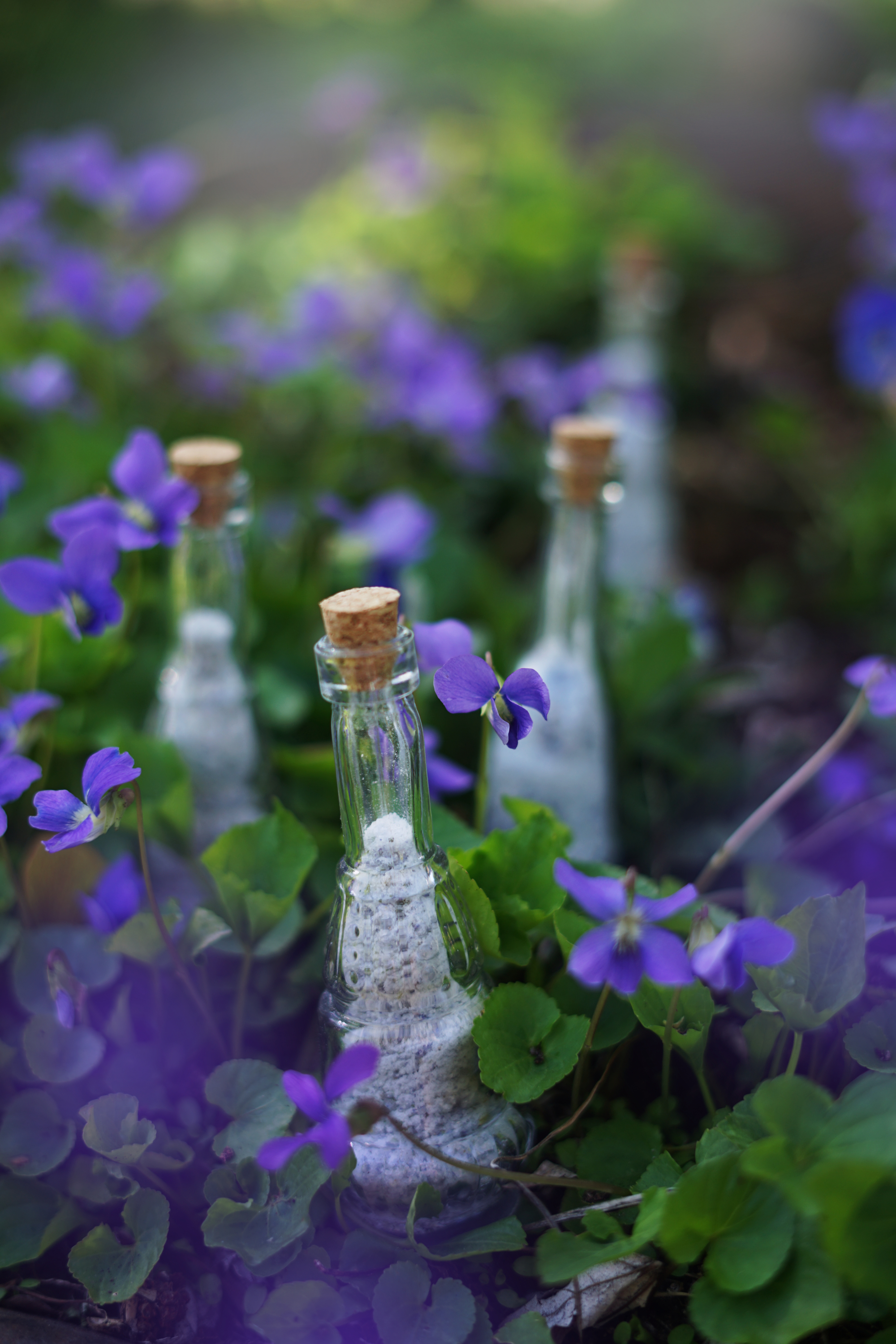The Secret Lives of Water Plants: Violet and Licorice Fern Sugar
The basics of plant life seem pretty easy to grasp: flowers are pollinated and turned into seeds, seeds are distributed and begin to germinate, seeds grow into the same plant as their parent. For some plants, though, things are not nearly this simple. There are plants that lead double underground lives, plants that shift between forms in an evolutionary dance, plants that act as beacons or secret agents. Two of the most intriguing plants I know are violets and ferns.
In spring, purple swaths of violets can be seen filling the woods and urban lawns with their clusters of dainty blossoms, so fragrant and alluring to both humans and pollinators. But later in the season, the violet plants grow another kind of flower… this time hidden underground, ghostly white and a bit translucent. These flowers are self-pollinating and create seedpods similar to the above-ground seedpods, but instead of brown seeds and green leaves, everything in this underground dance is ghostly white. Tiny white seeds that are reminiscent of pearls are released into the soil, where they make their way upwards to sprout into new violet plants. Why would each plant put so much energy into underground seed production when it creates perfectly beautiful above-ground flowers that attract pollinators? Biologists believe that the subterranean pearly seeds are for short-term survival; since they are direct copies of their parent plant, they may be better adapted to life in that particular location or climate. Meanwhile, above-ground seeds ensure a wider dispersal. Because they’ve been pollinated by other flowers, these seeds contain more genetic diversity, meaning that if they land in just the right place, they can begin a colony of their own. And so sweet little violets, so simple at first glance, have a sensual underground ghost dance, hidden from the rest of the world.
Ferns, too, dance through time in mysterious ways. One might think that the spores produced on a fern frond would grow directly into another fern plant, but this is untrue. Instead, the parent fern (a diploid sporophyte, if you want to get technical) produces spores that then grow into an entirely different plant! These are called haploid gametophytes and are much smaller plants than ferns, generally around the size of a fingernail. Interestingly, they are also heart-shaped, reminiscent of the form of violet leaves. These little gametophytes produce both eggs and sperm, which fertilizes the eggs in wet conditions. This creates a tiny little embryo, which then grows up from its parent gametophyte and becomes the ferns we know and recognize. Ferns have been around longer than most plants we recognize, twirling in their coupled dance for eons as other life evolved around them. Licorice ferns add another step to this dance, spreading their rhizomes (root-like structures) along mossy logs or forest floors and sprouting fronds along the way (instead of in one big cluster, like most other ferns.) In fact, it’s name is Polypodium (“many-footed”) glycyrrhiza (“sweet root”) - an apt description for a dancing plant with super sweet licorice-flavored rhizomes!
Perhaps these plants can offer some metaphorical inspiration for us, too. It’s almost as if the recognizable green ferns and purple violets we know so well are symbolic of the conscious mind, while the ghost flowers and tiny hearts buried by soil or obscured on the forest’s floor are our subconscious states; hidden, mysterious, and absolutely vital to our existence. They could also represent our outward presentation and mysterious inner states -- the masks the world sees and the secrets we hold with only ourselves. Just as we nurture our outward and awake selves, our inner selves need a little love too. When is the last time you paid attention to your dreams, or expressed your inner thoughts (even just to yourself?)
One way to access the hidden treasures and tucked-away shadows is to try stream-of-consciousness writing. This means you just grab a pencil and paper and just start to write. Anything that crosses your mind gets jotted quickly down, from the mundane to the magical. It’s a sort of subconscious purge, clearing out the muddying thoughts in your mind. You may find some interesting surprises show up amongst the ramblings. A very simple ritual to learn to “dance with yourself” could include a few quiet moments sipping tea flavored with the violet and licorice fern sugar below, then a session of stream-of-consciousness writing for about 20 minutes, then a short walk of reflection on the experience. Often, the wonder or secrets you’re craving to discover have been inside you all along, like little ghost flowers in your subconscious mind.
Violet and Licorice Fern Sugar:
The ionone-sweet fragrance of violets is harmonized with the sweet, earthy taste of licorice fern rhizomes. The resulting sugar is a beautiful purple and can be used as a ritual tool of sacred alone time (see above) or just an interesting culinary treat! Try it sprinkled over dark chocolate ice cream or a lemon tart.
Ingredients:
1” section of licorice fern rhizome
1 c. fresh violet flowers
1 c. granulated sugar
Directions:
In a food processor or mortar and pestle, grind the cleaned licorice fern rhizome with ⅓ c. of sugar until it’s finely ground. Add the violets and process again until smooth.
Add the remaining sugar and pulse to combine. Spread the purple paste out on a non-stick surface to dry completely, then break up into small chunks. Use in drinks, baked goods, or other treats!
Love what you’ve read here? Don’t forget to Subscribe to get frequent updates of new posts!
Huge thanks to my Patrons that make sharing all of these lovely posts with you possible (without all of the pop-ups and ads that make browsing other blogs so annoying). If you’re feeling generous, you too can support the wonder with a monthly contribution of your choice. Even $1 helps a lot! Your donation will help to fund this blog as well as my surprise free events and gifts for strangers. Learn more about this program at the link below:
*New to foraging and don’t know where to start? Check out this blog post on Foraging 101!




















Join me for a little winter night magic as we bake this cake full of rich seasonal flavors and black cocoa!